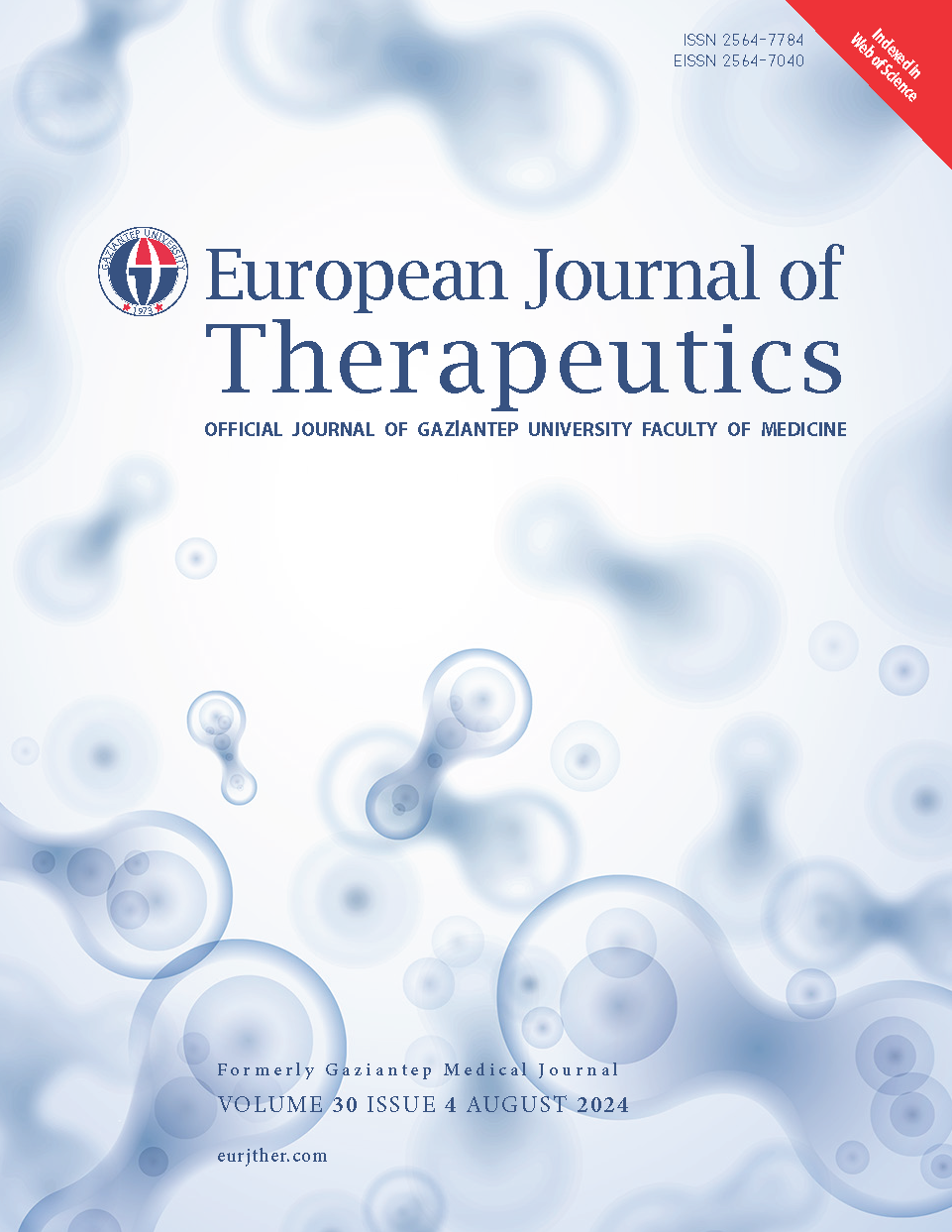Can Incidental Cancer be Predicted Before Cholecystectomies for Benign Diseases?
DOI:
https://doi.org/10.58600/eurjther2226Keywords:
Acute Cholecystitis, Cholecystectomy, Gallbladder Neoplasms, Gallstones, PolypsAbstract
Objective: Gallbladder cancer is a rare disease with a high mortality rate. The gold standard of treatment is based on early diagnosis and eradication of the disease with effective surgery. Almost 70% of cases are detected incidentally in the final pathology report of routine cholecystectomies. Our study aims to predict incidental gallbladder cancer in patients scheduled for surgery for benign reasons.
Methods: Biological characteristics, medical history, family history of hepatobiliary disease, radiological imaging, and laboratory parameters were analyzed in 2852 patients operated on for benign reasons in the general surgery department over 63 months. Patients with incidental gallbladder cancer were compared with patients with cholecystitis. The effects of independent variables in predicting cancer between the two groups were analyzed.
Results: Of 2852 patients who underwent cholecystectomy, 13 (0.45%) had incidental gallbladder cancer. The cancer incidence rate was 0.28% (2/700) in men and 0.51% (11/2139) in women. This difference was not statistically significant (p: 0.34). Among the biological characteristics, history of acute cholecystitis (p: 0.001), and laboratory findings, neutrophil-to-lymphocyte ratio (NLR) (p: 0.001) were the most striking variables. When variables with proven statistical value were tested by logistic regression analysis, NLR (p: 0.001), biliary polyps (p: 0.001), and gallstones (p: 0.038) were ranked as the most valuable cancer predictors, respectively.
Conclusions: In older patients with a history of acute cholecystitis, especially if there are large stones, polyps, and wall thickening on imaging, the possibility of cancer should be considered considering the NLR value, and surgery should be performed under optimal conditions by informing the patient and relatives.
Metrics
References
Kapoor VK, McMichael AJ (2003) Gallbladder cancer: an 'Indian' disease. Natl Med J India. 16(4):209-213.
Rawla P, Sunkara T, Thandra KC, Barsouk A (2019) Epidemiology of gallbladder cancer. Clin Exp Hepatol. 5(2):93-102. https://doi.org/10.5114/ceh.2019.85166
Goetze TO, Paolucci V (2009) Use of retrieval bags in incidental gallbladder cancer cases. World J Surg. 33(10):2161-5. https://doi.org/10.1007/s00268-009-0163-7
Rathanaswamy S, Misra S, Kumar V, Chintamani, Pogal J, Agarwal A, Gupta S (2012) Incidentally detected gallbladder cancer- the controversies and algorithmic approach to management. Indian J Surg. 74(3):248-54. https://doi.org/10.1007/s12262-012-0592-7
National Comprehensive Cancer Network (2023) Gallbladder Cancer (Version 3.2023). Available from https://www.nccn.org/professionals/physician_gls/pdf/btc.pdf
Dowling GP, Kelly JK (1986) The histogenesis of adenocarcinoma of the gallbladder. Cancer. 15;58(8):1702-8. https://doi.org/10.1002/1097-0142(19861015)58:8<1702::aid-cncr2820580821>3.0.co;2-z
Konstantinidis IT, Deshpande V, Genevay M, Berger D, Fernandez-del Castillo C, Tanabe KK, Zheng H, Lauwers GY, Ferrone CR (2009) Trends in presentation and survival for gallbladder cancer during a period of more than 4 decades: a single-institution experience. Arch Surg. 144(5):441-7; discussion 447. https://doi.org/10.1001/archsurg.2009.46
Kamisawa T, Munakata W, Tu Y, Egawa N, Tsuruta K, Okamoto A (2008) Sex-based differences in gallbladder cancer associated with pancreaticobiliary maljunction. Hepatogastroenterology. 55(81):21-3
Downing SR, Cadogan KA, Ortega G, Oyetunji TA, Siram SM, Chang DC, Ahuja N, Leffall LD Jr, Frederick WA (2011) Early-stage gallbladder cancer in the Surveillance, Epidemiology, and End Results database: effect of extended surgical resection. Arch Surg. 146(6):734-8. https://doi.org/10.1001/archsurg.2011.128
Jaruvongvanich V, Yang JD, Peeraphatdit T, Roberts LR (2019) The incidence rates and survival of gallbladder cancer in the USA. Eur J Cancer Prev. 28(1):1-9. https://doi.org/10.1097/CEJ.0000000000000402
Shirai Y, Sakata J, Wakai T, Ohashi T, Hatakeyama K (2012) "Extended" radical cholecystectomy for gallbladder cancer: long-term outcomes, indications and limitations. World J Gastroenterol. 14;18(34):4736-43. https://doi.org/10.3748/wjg.v18.i34.4736
Creasy JM, Goldman DA, Gonen M, Dudeja V, Askan G, Basturk O, Balachandran VP, Allen PJ, DeMatteo RP, D'Angelica MI, Jarnagin WR, Peter Kingham T (2017) Predicting Residual Disease in Incidental Gallbladder Cancer: Risk Stratification for Modified Treatment Strategies. J Gastrointest Surg. 21(8):1254-1261. https://doi.org/10.1007/s11605-017-3436-8
Muszynska C, Nilsson J, Lundgren L, Lindell G, Andersson R, Sandström P, Andersson B (2020) A risk score model to predict incidental gallbladder cancer in patients scheduled for cholecystectomy. Am J Surg. 220(3):741-744. https://doi.org/10.1016/j.amjsurg.2020.01.039
Goussous N, Maqsood H, Patel K, Ferdosi H, Muhammad N, Sill AM, Kowdley GC, Cunningham SC (2018) Clues to predict incidental gallbladder cancer. Hepatobiliary Pancreat Dis Int. 17(2):149-154. https://doi.org/10.1016/j.hbpd.2018.02.001
Kumari S, Tewari S, Husain N, Agarwal A, Pandey A, Singhal A, Lohani M (2016) Quantification of Circulating Free DNA as a Diagnostic Marker in Gall Bladder Cancer. Pathol. Oncol. Res. 23:91–97. https://doi.org/10.1007/s12253-016-0087-0
Kinugasa H, Nouso K, Ako S, Dohi C, Matsushita H, Matsumoto K, Kato H, Okada H (2018) Liquid biopsy of bile for the molecular diagnosis of gallbladder cancer. Cancer Biol. Ther. 19:934–938. https://doi.org/10.1080/15384047.2018.1456604
García P, Lamarca A, Díaz J, Carrera E, Roa JC (2020) On Behalf Of The European-Latin American Escalon Consortium. Current and New Biomarkers for Early Detection, Prognostic Stratification, and Management of Gallbladder Cancer Patients. Cancers (Basel). 7;12(12):3670. https://doi.org/10.3390/cancers12123670
Liu F, Hu HJ, Ma WJ, Yang Q, Wang JK, Li FY (2019) Prognostic significance of neutrophil-lymphocyte ratio and carbohydrate antigen 19-9 in patients with gallbladder carcinoma. Medicine (Baltimore). 98(8):e14550. https://doi.org/10.1097/MD.0000000000014550
Downloads
Published
How to Cite
Issue
Section
License
Copyright (c) 2024 European Journal of Therapeutics

This work is licensed under a Creative Commons Attribution-NonCommercial 4.0 International License.
The content of this journal is licensed under a Creative Commons Attribution-NonCommercial 4.0 International License.


















